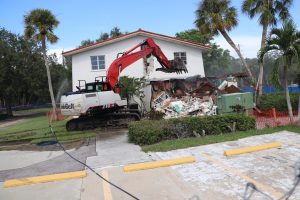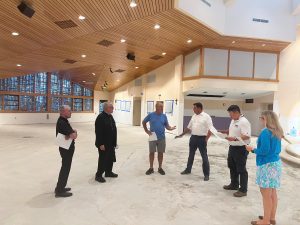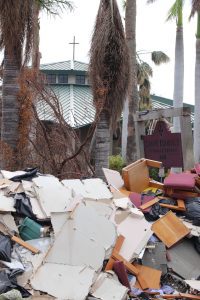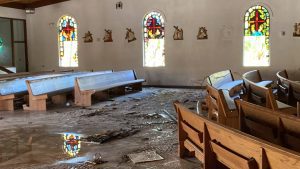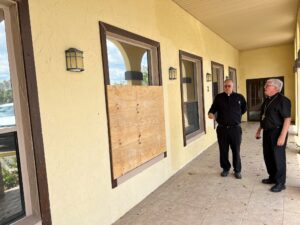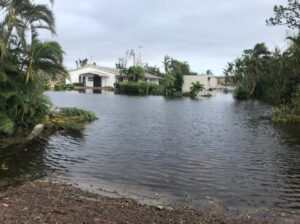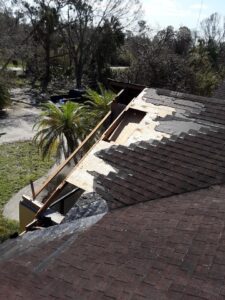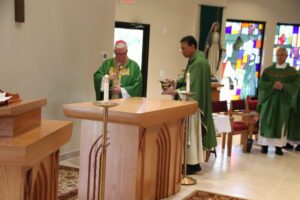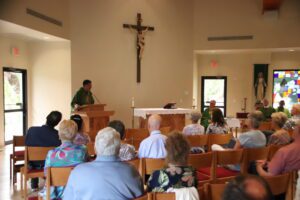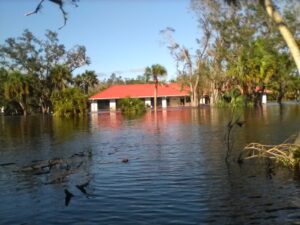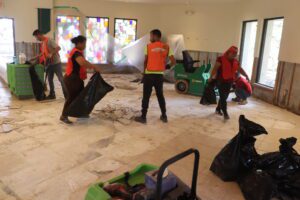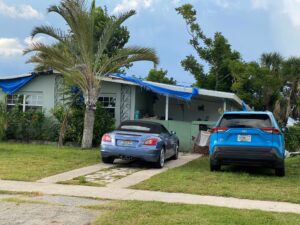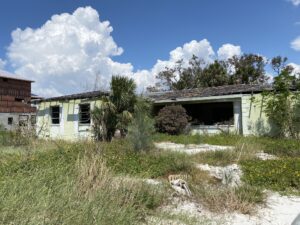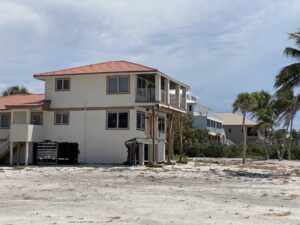Hurricane Helene brought destruction along the coast of the Diocese of Venice when it struck on Sept. 26, 2024. The storm, although its most fierce winds were more than 100 miles offshore, brought storm surge to the barrier islands and coastline, disrupting the lives of many families and doing damage to several Parishes.
An initial assessment of the damage revealed that two Diocesan Parishes suffered significant damage – Our Lady of Mercy in Boca Grande and St. Bernard in Holmes Beach. Meanwhile, other Diocesan Parishes fortunately only had relatively minor damage to landscaping and other infrastructure. No damage was reported at any Diocesan Catholic school. Part of the reason for the limited damage to Diocesan properties is credited to a multi-phased program to upgrade vulnerable buildings from wind and water damage. These worked well during Helene.
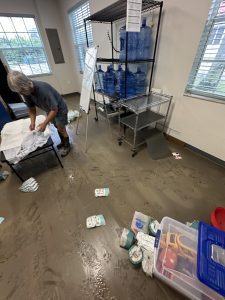
Damage evaluations began as soon as Helene passed or when the winds and storm surge receded, and it was deemed safe to enter various areas. Representatives from the Diocese of Venice Buildings and Construction Office, as well as Parish staff did surveys and called for disaster remediation companies to help assist in drying out buildings and cleaning up structures. Access to some properties was delayed in some cases due to barrier islands being cut off by storm surge.
The storm surge from Hurricane Helene reached record levels (between 3 and 8 feet) in many areas, while other communities still recovering from Hurricane Ian in 2022 saw impacts once again. The communities of Naples, Bonita Springs, Fort Myers Beach, Sanibel, Fort Myers, Pine Island, Punta Gorda, Boca Grande, Engelwood, Venice, Nokomis, Siesta Key, Longboat Key, Sarasota, Anna Maria Island and Bradenton all experienced storm surge, destroying or severely damaging many homes and businesses.
Bishop Frank J. Dewane has been actively monitoring the Diocesan response to Hurricane Helene, directing all resources necessary to support both the people in need, as well as the Parishes that received damage.
“The prayers of the Diocese of Venice go out to all who have been impacted by Hurricane Helene, whether they are in our coastal communities, elsewhere in Florida, or throughout the Southeast where the storm caused catastrophic flooding and devastation,” Bishop Dewane said. “We pray to ask God’s blessing; that He place His healing hand upon all who suffer as a result of Hurricane Helene.”
Catholic Charities
Catholic Charities, Diocese of Venice, Inc., activated its emergency response plan and have set up an emergency point of distribution at St. Bernard Parish on Holmes Beach. This site opened Oct. 3, and will be open 10 a.m. to 3 p.m. on Oct. 5, Oct. 8 and Oct. 10.
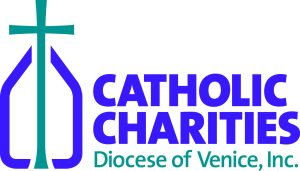
The site offers food and water. In addition, disaster case management staff will be present to offer immediate assistance in the wake of the hurricane; namely to help acquire and or retain permanent housing, provide rental assistance and utility payments. The case management staff also help individuals and families cope with changes while home repairs are being made and helps them access available resources through Catholic Charities and partner agencies.
Disaster case managers are also available to offer assistance through the individual county offices of Catholic Charities. For contact information about reaching a specific Catholic Charities regional office, please visit https://catholiccharitiesdov.org/. This site also provides information about how to register for federal assistance and offers the opportunity for the faithful to donate to support the ongoing disaster recovery work of Catholic Charities.
Worst Parish impacts
St. Bernard Parish, which is on Anna Maria Island in Holmes Beach, suffered storm surge damage to multiple buildings. Thankfully, the Parish church was spared any serious damage as the surge did not enter the building, however infrastructure, such as HVAC units were exposed to salt water. A least 2 feet of storm surge entered the Parish Hall which houses several offices, activity rooms and other storage. All flooring and doors require replacement, while baseboard, bookcases, storage cabinets, and nearly allo of the furniture is damaged beyond repair. In addition, two pianos and an organ were damaged in the hall. Water also intruded into the ground floor of the rectory, as well as a maintenance building. While most Parish activities have been cancelled, the Holy Sacrifice of the Mass resumed on Monday, Sept. 30.
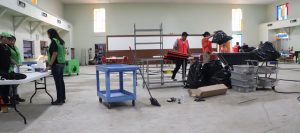
Father Philip Schweda, Administrator of St. Bernard, said he evacuated and watched on the security cameras as the water rose until the power went out.
“Then I knew it was going to get bad,” Father Schweda said. “When I returned and saw how much water was in the hall and the maintenance building, I knew we lost nearly everything.”
The hall is structurally sound, having been built with cinderblocks, but each of the doors and anything made with less sturdy material was ruined. Disaster mitigation teams were at the Parish by Oct. 1, first clearing the muck and debris off the floor, before removing all of the destroyed furniture.
The surrounding neighborhood also suffered greatly with the ground floor of every home and business filled with wet sand. The water and electricity in the area is slowly coming back online.
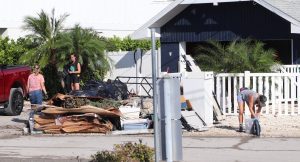 Parishioner Miranda Riley, who lives a few blocks from the Parish and faces the Gulf of Mexico, said her home’s ground floor, which included a rec room, office and two car garage, were destroyed with more than four feet of water.
Parishioner Miranda Riley, who lives a few blocks from the Parish and faces the Gulf of Mexico, said her home’s ground floor, which included a rec room, office and two car garage, were destroyed with more than four feet of water.
“It is very overwhelming,” Riley said. “All of the business records (in her home) are gone. It is hard to know where to start the cleanup. However, we are blessed that we are safe, and our neighbors are safe. That’s really what matters.”
Our Lady of Mercy Parish, on Gasparilla Island in Boca Grande, suffered damage from its fourth hurricane in the last 20 years (Charley 2004; Irma 2017; Ian 2022; and Helene 2024). This time, the damage came from the storm surge, which caused 8-inches of water to enter the Parish church and 2-feet to inundate the neighboring Boca Grande Preschool.
While devastating, the structures are both sound, and mitigation work began by Sept. 28, the two-year anniversary of Hurricane Ian which ripped the roof off of the church, rectory and the preschool. In addition to removing various vegetative and sand debris from the property, all destroyed furniture was taken away and the initial drying out of the impacted buildings commenced with parishioners and contractors working together.
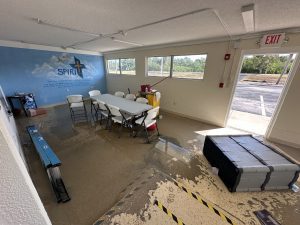
The church kneelers, doors and air handlers were severely damaged. In the preschool, which is operated by Catholic Charities, nearly all of the furniture is unsalvageable due to saltwater inundation. As part of the mitigation process to both buildings, any impacted drywall was removed in a line at least 18 inches above the high-water mark to prevent additional damage. The floors and electrical systems will be reassessed in the coming days, once the initial drying out and cleaning process is completed. This will allow experts to ensure all damage is identified before extensive repairs can be made in earnest.
Father Anthony Hewitt, Pastor of Our Lady of Mercy, asked that everyone keep the people of the Parish and Boca Grande in their prayers as they recover from the latest storm.
At St. Isabel Parish on Sanibel, the island was once again covered in storm surge. However, the Parish was spared major damage as no water got into any buildings, a big change from Hurricane Ian when the surge overwhelmed all of the buildings, causing severe damage. Helene caused damage to the parking lot, cladding and landscaping at the Parish. The repairs from Ian are expected to be completed in the coming months and the impacts of Helene are not expected to delay that work, said Parish Business Manager Khristy Scheer. Helene’s surge did impact many low-lying businesses and homes on the island, bringing renewed destruction for those still weary from the destruction Ian brought two years earlier.
St. Michael the Archangel Parish, which is on Siesta Key in Sarasota, was surrounded by waist-deep water but had no damage. The same was true for St. Mary, Star of the Sea Parish on Longboat Key, off the coast of Manatee County. In fact, Mass was celebrated the morning the storm arrived, as well as the next morning, with six people present. Both island communities suffered severe damage with many homes and businesses demolished by the surge of water. Even a week after the storm, access to all barrier islands in Sarasota and Manatee counties is severely limited.
Other Diocesan Parishes had water on the property, trees and branches down and some debris to clean up, but all were open for the Holy Sacrifice of the Mass as soon as the storm passed. All Diocesan Catholic schools were closed Sept. 25-27, with only St. Catherine School in Sebring opening on Sept. 27. All other schools reopened on Sept. 30.

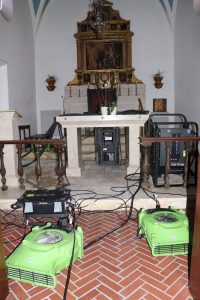





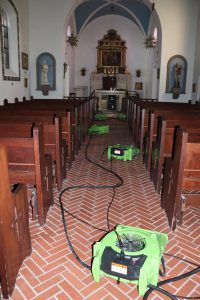
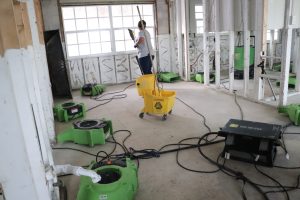 In addition, Milton’s water reached the rectory. While the water did not reach the flooring, it did damage the garage and crawlspace where various utilities were located.
In addition, Milton’s water reached the rectory. While the water did not reach the flooring, it did damage the garage and crawlspace where various utilities were located.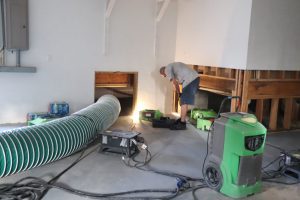 Working under the direction of staff from the Diocese of Venice Buildings and Construction Office, contractors have removed all the debris from the church, preschool and rectory as part of the mitigation work. How best to proceed with the reconstruction of each building will be determined in the coming days and weeks.
Working under the direction of staff from the Diocese of Venice Buildings and Construction Office, contractors have removed all the debris from the church, preschool and rectory as part of the mitigation work. How best to proceed with the reconstruction of each building will be determined in the coming days and weeks.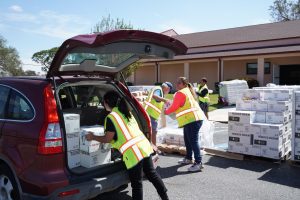

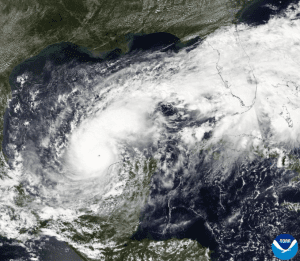 As soon as it was safe to do so, teams from the Diocese of Venice Office of Buildings and Construction, along with officials from each Parish and Diocesan Catholic school, were out making initial assessments of the damage. Bishop Dewane was in contact with priests, religious and Diocesan staff to ensure all were accounted for, and safe.
As soon as it was safe to do so, teams from the Diocese of Venice Office of Buildings and Construction, along with officials from each Parish and Diocesan Catholic school, were out making initial assessments of the damage. Bishop Dewane was in contact with priests, religious and Diocesan staff to ensure all were accounted for, and safe.




 Parishioner Miranda Riley, who lives a few blocks from the Parish and faces the Gulf of Mexico, said her home’s ground floor, which included a rec room, office and two car garage, were destroyed with more than four feet of water.
Parishioner Miranda Riley, who lives a few blocks from the Parish and faces the Gulf of Mexico, said her home’s ground floor, which included a rec room, office and two car garage, were destroyed with more than four feet of water.
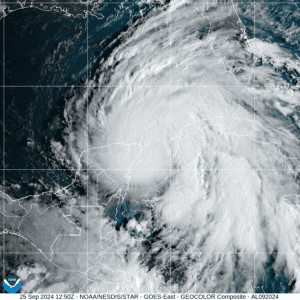 As Hurricane Helene approached, Bishop Dewane met with members of the Diocesan Emergency Response Team on Sept. 24 and 25, 2024, at the Catholic Center. The first of these meetings was to review and then implement existing emergency plans for all Parishes, Schools and other entities within the Diocese. The storm approaches the region near the second anniversary of the devastating Hurricane Ian. That hurricane caused widespread wind, storm surge, and flooding damage throughout the Diocese. Some of those recovery efforts are ongoing.
As Hurricane Helene approached, Bishop Dewane met with members of the Diocesan Emergency Response Team on Sept. 24 and 25, 2024, at the Catholic Center. The first of these meetings was to review and then implement existing emergency plans for all Parishes, Schools and other entities within the Diocese. The storm approaches the region near the second anniversary of the devastating Hurricane Ian. That hurricane caused widespread wind, storm surge, and flooding damage throughout the Diocese. Some of those recovery efforts are ongoing.